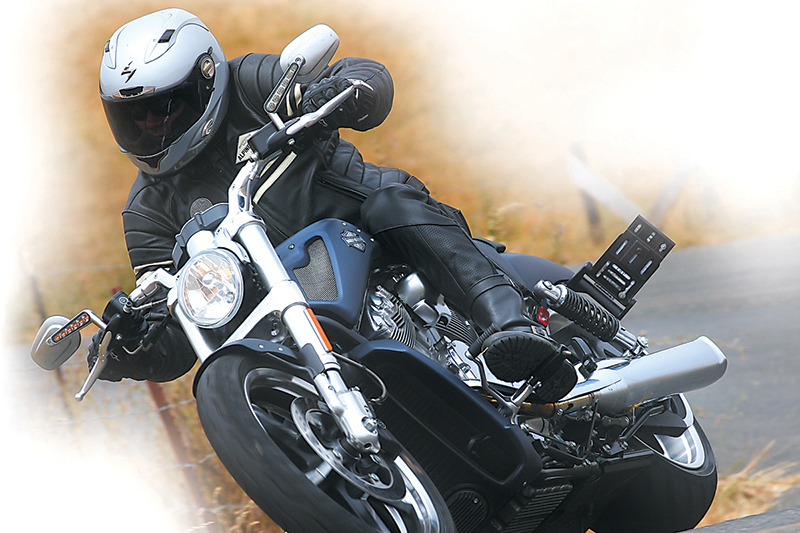2009 Harley-Davidson V-Rod Muscle

Road Test Review
Harley’s V-Rod is the young black sheep in Milwaukee’s 106-year-old family. Introduced in 2001, the V-Rod rebelled against tradition with a liquid-cooled, fuel-injected, double-overhead-cam engine and non-conformist styling. Like the growing pains of a confused teenager, the V-Rod seems to have struggled with its identity.
The V-Rod has reinvented itself over time like Madonna on two wheels. Debuting with futuristic anodized aluminum bodywork and solid disc wheels, later models offered different colors, wheels and accessories. In 2005 and 2006, Harley produced limited-edition CVO V-Rods that boosted engine displacement from 1,130cc to 1,250cc and widened the rear tire from 180mm to 240mm, changes that soon became standard on all V-Rods.
With a steeper rake, male-slider fork, deeper lean angle and mid-mount controls, we swooned over the sporting prowess of the 2006 Street Rod (Rider, April 2005). But, as often happens with a romantic crush, it was short-lived. Poor sales led the Street Rod to be dropped after 2007. Entering a brooding phase, the blacked-out Night Rod emerged in 2006, which became the even blacker “Dark Custom” Night Rod Special in 2008.
For 2009, the V-Rod and Night Rod Special are joined by a third model: The Muscle. At last, a V-Rod that has outgrown its awkward styling. Retaining the hydroformed, tubular frame and raked-out look, the new “tank” (fuel is stored under the seat) is more angular. Wire mesh scoops are reminiscent of ram-air ducts on muscle cars but are for looks only. Pewter powdercoating and polished covers sharpen the look of the V-twin engine.
Attention to detail is first-rate. Dual satin-finished side exhausts, clipped front and rear fenders (with an LED stop/tail/turn light tucked under the rear), LED front turn signals integrated in mirror stems, side-mount license plate and silver five-spoke cast-aluminum wheels look custom but not flashy. Redesigned radiator shrouds, new internally wired handlebar and riser, new instrument cluster and a black frame complete the clean, mean profile.
As if carved from stone, the Muscle feels solid and stable. Suspension is firm and reassuring over smooth pavement, but it bucks like a mechanical bull over the rough stuff. With only 4 inches of travel in the nonadjustable, 43mm male-slider fork and 2.9 inches of travel in the preload-adjustable rear shocks, the suspension bottoms out easily. The firm seat and clamshell riding position mean that, when the rear shocks fully compresses (often), the only thing left to squish are the discs between your vertebrae. Ouch.
At speed, the sloped headlight deflects wind reasonably well. But the peg position and tank shape make it difficult to hold the bike firmly between your knees. The faster you go, the worse it gets, as windblast splays your legs apart awkwardly. Long-distance riding is not pleasant, which became abundantly clear about 50 miles into my 400-mile test loop.
New gauge faces are attractive but hard to read in bright sunlight. However, at night, bright-orange back lighting makes a dramatic difference. Cleverly, the fuel gauge needle turns red at one-quarter tank; low-fuel light soon follows. Nonadjustable clutch and front brake levers are well-placed and nicely shaped.
Brembo brakes-300mm rotors (two in front, one in rear) squeezed by four-piston calipers-provide excellent stopping power. Our test bike was equipped with optional ABS. If you grab or stomp hard, the system kicks back like a mule, as if the brakes are disagreeing with your decision to stop right now. Unsettling, but the ABS does its job well.
I’m a big fan of the 1,250cc Revolution V-twin motor. Strong, linear power delivers hang-on-tight acceleration. And it loves to rev, unlike air-cooled Harley motors that are happiest when short-shifted and loping along at low rpm. On the Jett Tuning Dynojet dyno, the Muscle cranked out 110 horsepower at 8,300 rpm and 77 lb-ft of torque at 6,900 rpm. The power curve grows smoothly and linearly, and torque is abundant everywhere.
During the V-Rod Muscle intro, Harley let us loose on the Infineon Raceway dragstrip-a first for me. After overcoming newbie jitters about doing burnouts and reacting to the starting lights, I quickly became hooked. The Revolution motor pulled hard, and the smooth transmission made clutchless upshifts a snap. Fourteen quarter-mile runs in all, my best (11.875 seconds and 114.19 mph) earned me top rookie honors.
But the Muscle starts swimming out of water when the tarmac starts to undulate. A long wheelbase, lots of trail and rake, 670 pounds and a 240mm rear tire heavily tip the scales in favor of straight-line stability rather than flickability. Like me sitting on a seesaw with my girlfriend. Turn-in requires muscle, but once you get leaned over the bike remains steady. In tight turns, the first thing to scrape the pavement is your boot heel, soon followed by the folding pegs.
The V-Rod Muscle’s style still has a bit of maturing to do, as the exhaust heat shields don’t extend far enough rearward. When I stood up at a light to get something out of my pocket, I left a stinky coating of melted Cordura on both pipes (grilled Aerostich, anyone?), a problem likely to occur with anything other than leather or denim. These literal black marks join the uncomfortable seating position, limited suspension travel and poor fuel economy (25.8 mpg during my 1,200-mile test) as strikes against what is a well-sorted, sharp-looking bike with an awesome motor.
